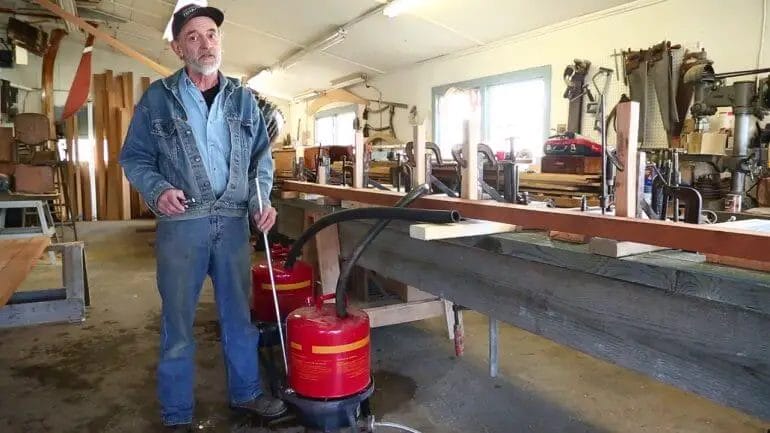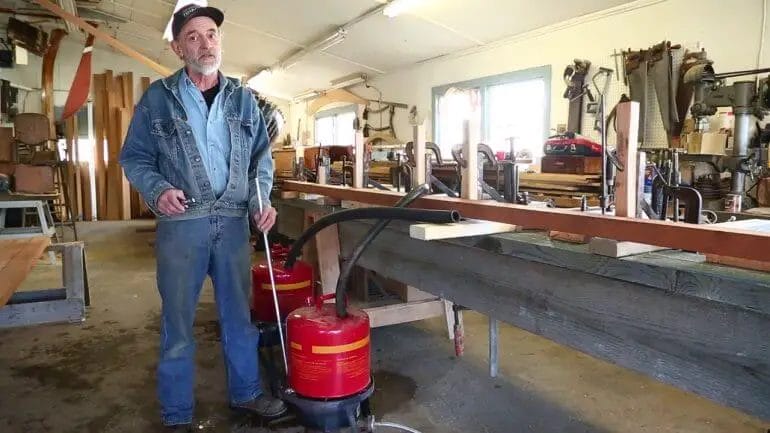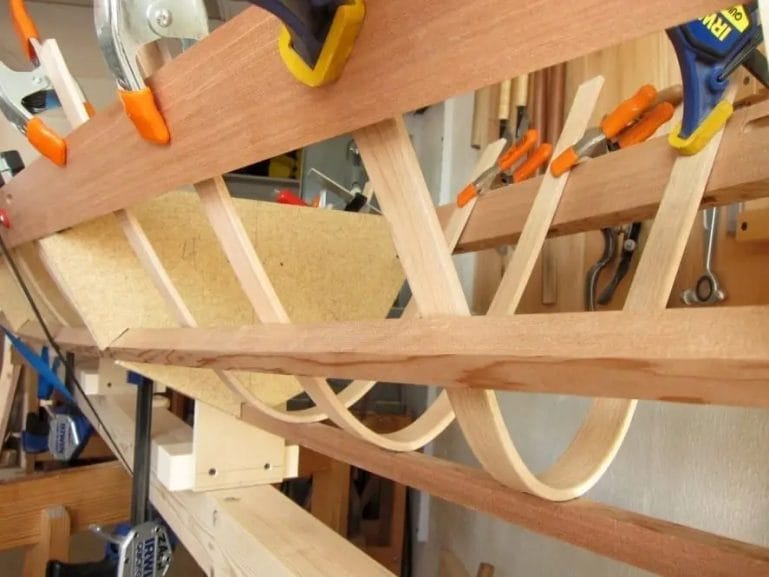Looking to bend wood without steam? Discover a simple and efficient technique to achieve curved wood without the hassle of using steam. With this innovative method, you can effortlessly bend wood to create stunning furniture pieces, decorative accents, or any other woodworking project you have in mind.
By following this step-by-step process, you can achieve precise and controlled bends, without the need for specialized equipment or lengthy setup. Say goodbye to the traditional steam bending method and unlock a whole new world of possibilities with this alternative approach.

Whether you’re a professional woodworker or a DIY enthusiast, this technique offers a convenient and accessible way to bend wood to your desired shape. Get ready to unleash your creativity and bring your woodworking projects to life with ease. Let’s dive in and explore how to bend wood without steam!

Using Hot Water for Wood Bending
Wood bending is a technique that allows you to create unique shapes and curves in wooden pieces. Traditionally, steam has been used to soften the wood fibers, making it more pliable for bending. However, an alternative method that can be just as effective is using hot water. In this section, we will explore the process of bending wood using hot water and the advantages it offers.
1. Understanding the Basics of Wood Bending
Before delving into the specifics of using hot water for wood bending, it’s important to understand the basic principles of this technique. Wood has a natural flexibility that can be manipulated when exposed to heat and moisture. By softening the wood fibers, you can bend the wood to your desired shape. This process is commonly used in woodworking projects such as furniture making, musical instrument construction, and even boat building.
2. The Benefits of Using Hot Water
Using hot water for wood bending offers several advantages over traditional steam bending. First and foremost, hot water is more accessible and easier to handle compared to steam. You don’t need specialized equipment like a steam box or a steam generator. All you need is a container large enough to submerge the wood in hot water.
In addition, hot water has a gentler heating process compared to steam. This can be beneficial when working with delicate or thin pieces of wood that may be prone to scorching or damage from high temperatures. The controlled heat from hot water allows for more precise bending without compromising the structural integrity of the wood.
3. The Process of Using Hot Water for Wood Bending
Now let’s dive into the step-by-step process of using hot water for wood bending:
- Choose the wood: Select a suitable wood species for bending. Softer woods like ash, pine, or cedar are more flexible and easier to work with.
- Prepare the wood: Cut the wood into the desired length and thickness. It’s recommended to soak the wood in water for at least 24 hours before the bending process to ensure even moisture distribution.
- Heat the water: Fill a container with hot water. The water should be heated to a temperature of around 150-170°F (65-75°C).
- Submerge the wood: Immerse the wood in the hot water and let it soak for at least 30 minutes. This allows the wood fibers to absorb moisture and become more pliable.
- Bend the wood: Once the wood has soaked sufficiently, remove it from the water and gently bend it to the desired shape. Use clamps or other tools to hold the wood in place until it cools and dries.
- Allow the wood to dry: Leave the bent wood in a cool, dry place to dry completely. This may take several days or even weeks, depending on the thickness and species of wood.
Remember to wear protective gloves and take necessary safety precautions when handling hot water and working with power tools during the wood bending process.
4. Tips for Successful Wood Bending with Hot Water
Here are some additional tips to ensure successful wood bending using hot water:
- Experiment with different soaking times: Depending on the wood species, thickness, and desired bend, you may need to adjust the soaking time. Thicker or harder woods may require longer soaking periods.
- Use a bending form or jig: To achieve consistent and precise bends, consider using a bending form or jig. These tools can help guide the wood into the desired shape and maintain the bend during the drying process.
- Gradually increase the bend: If you need to achieve a tight or extreme bend, it’s best to gradually increase the bend over multiple soaking and drying cycles. This prevents the wood from cracking or breaking under excessive pressure.
- Consider wood conditioning: In some cases, particularly with older or drier wood, pre-conditioning the wood with steam or a damp cloth before hot water bending can improve flexibility and reduce the risk of cracking.
By following these tips and techniques, you can successfully bend wood using hot water as an alternative to traditional steam bending methods.

Electrical Resistance Bending
Wood bending is a technique that allows you to shape wood in ways that were previously considered impossible. One fascinating method of achieving this is through electrical resistance bending. In this section, we will explore the process of bending wood using electrical resistance and the steps involved in this innovative technique.
What is Electrical Resistance Bending?
Electrical resistance bending is a woodworking technique that involves the use of electric current to soften and shape wood. By passing an electrical current through the wood, the moisture content within the fibers is heated, making the wood more pliable and allowing it to be bent. This method enables woodworkers to create unique, curved designs that would be challenging to achieve using conventional bending techniques.
The Process
The process of electrical resistance bending involves several steps that need to be followed precisely to achieve the desired results. Let’s delve into each of these steps:
1. Selecting the Wood
The first step in electrical resistance bending is to choose the right type of wood. It is crucial to select a wood species that is suitable for bending. Woods with long fibers, such as oak or ash, are ideal for this technique. Additionally, the moisture content of the wood should be around 20-25% to ensure proper bending.
2. Creating the Form
Before bending the wood, it is essential to create a bending form or mold. The form is typically made of metal and shaped according to the desired curve. The wood will be bent around this form, so its accuracy and dimensions are crucial to achieving the desired shape.
3. Preparing the Wood
Once the form is ready, the wood needs to be prepared for the bending process. This involves cutting the wood into appropriately sized and shaped pieces that can be manipulated easily. The ends of the wood should also be sealed to prevent excessive moisture loss during bending.
4. Applying Electric Current
Now comes the exciting part. The wood is placed on the bending form, and copper electrodes connected to a power source are positioned on either side of the wood. When the current is applied, the electrical resistance within the wood generates heat, which softens the lignin and cellulose, making the wood pliable.
5. Bending the Wood
As the wood heats up and becomes more flexible, it can be carefully bent around the form. This requires precision and patience to ensure the desired curve is achieved. The bending process should be gradual to prevent cracking or damaging the wood fibers.
6. Cooling and Setting the Bend
Once the wood has been bent to the desired shape, it needs to be cooled and set in place. This involves keeping the wood in the bent position while it cools down and the lignin and cellulose harden again. Clamps or straps can be used to hold the wood securely until it sets.
7. Finishing Touches
After the wood has cooled and set, any excess moisture can be removed, and the final touches can be added. This may include sanding, smoothing, and applying a protective finish to enhance the appearance and durability of the bent wood piece.
Advantages of Electrical Resistance Bending
Electrical resistance bending offers several advantages over traditional wood bending methods:
- Greater precision: The use of electrical resistance allows for more controlled and precise shaping of the wood.
- Reduced risk of breakage: The gradual heating and bending process minimizes the risk of wood cracking or breaking.
- Ability to bend complex shapes: Electrical resistance bending enables the creation of intricate and complex curved designs that would be challenging to achieve with other methods.
- Time-efficient: Compared to steam bending, electrical resistance bending is generally faster, allowing for quicker production times.
In summary, electrical resistance bending is an innovative technique that offers woodworkers the ability to bend wood in unique ways. By understanding the process and following the necessary steps, woodworkers can unlock new possibilities in their craft and create stunning curved wood pieces.

Chemical Softening for Wood Bending
Wood bending is a technique used in various woodworking projects to create curved or rounded shapes. However, bending wood can be challenging, especially when working with hardwoods that are naturally rigid and resistant to bending. In such cases, chemical softening techniques can be employed to make the wood more pliable, allowing for easier bending and shaping.
Chemical softening involves treating the wood with specific chemicals that break down the lignin and cellulose fibers within the wood, making it more flexible and bendable. There are several chemical treatments available, each with its own advantages and considerations.
1. Steam Bending
Steam bending is one of the most commonly used chemical softening techniques for wood bending. It involves exposing the wood to steam, which softens the lignin and cellulose fibers. The wood is then placed in a bending form and allowed to dry, retaining its new shape.
Steam bending is suitable for a wide range of wood species and can produce tight curves and complex shapes. It is commonly used in furniture making, musical instrument construction, and boat building.
2. Ammonia Fuming
Ammonia fuming is a chemical treatment that involves exposing the wood to ammonia gas. The ammonia reacts with the tannins present in the wood, softening the fibers and making them more pliable. This technique is often used for bending oak, which has a high tannin content.
Ammonia fuming requires a specialized setup, as the wood needs to be enclosed in an airtight container with the ammonia gas. The duration of the fuming process depends on the desired level of softening.
3. Lye Treatment
Lye treatment, also known as caustic soda treatment, involves immersing the wood in a solution of lye and water. The caustic properties of lye break down the lignin in the wood, making it more flexible and easier to bend.
This method is commonly used for bending woods such as ash, hickory, and beech. The duration of the lye treatment varies depending on the wood species and desired flexibility.
4. Hot Water Soaking
Hot water soaking is a simple and effective method for softening wood for bending. The wood is immersed in hot water for an extended period, allowing the heat and moisture to penetrate the fibers and soften them.
This technique is commonly used for bending thin strips of wood and is often employed in woodworking projects such as chair seats, handles, and trim pieces.
Considerations and Safety Precautions
When using chemical softening techniques, it is important to follow proper safety precautions to ensure personal safety and the integrity of the wood. Some considerations include:
- Wearing protective gloves and goggles when handling chemicals
- Working in a well-ventilated area to prevent inhalation of fumes
- Using appropriate containers and equipment for the specific chemical treatment
- Following the recommended treatment duration and procedures for each technique
- Allowing the wood to fully dry and acclimate after the softening treatment
In summary, chemical softening techniques offer woodworkers the ability to bend and shape rigid woods with greater ease. Steam bending, ammonia fuming, lye treatment, and hot water soaking are all effective methods for softening wood fibers. However, it is important to exercise caution and follow proper safety procedures when working with chemicals. With the right approach, chemical softening can unlock a whole new world of design possibilities in woodworking.
Mechanical Bending Methods
When it comes to bending wood, the traditional method involves the use of steam to soften the fibers and make the wood pliable. However, there are also mechanical techniques available that allow for wood bending without the use of steam. In this section, we will explore some of these methods and how they can be used to achieve the desired bend in wood.
1. Laminating
Laminating is a technique that involves layering thin strips of wood together and gluing them to create a curved shape. This method is commonly used in the production of furniture and musical instruments. By stacking and gluing multiple layers of wood, the resulting structure becomes flexible and can be bent to a desired shape.
One of the advantages of laminating is that it allows for greater control over the bending process. Different thicknesses and types of wood can be combined to achieve the desired strength and flexibility. Additionally, laminating can be used to create complex curves and shapes that may be difficult to achieve with other methods.
2. Kerf Bending
Kerf bending is a technique that involves making a series of cuts, known as kerfs, into the wood at regular intervals. These cuts weaken the fibers of the wood, making it easier to bend. The wood is then clamped or held in place while it is slowly bent into the desired shape.
One of the advantages of kerf bending is that it is a relatively simple and inexpensive method. It does not require specialized equipment or materials, making it accessible to a wide range of woodworkers. However, it is important to note that kerf bending is best suited for small or medium-sized bends, as larger bends may result in the wood breaking or splintering.
3. Compression Bending
Compression bending is a technique that involves applying pressure to the wood to force it into a curved shape. This is typically achieved by clamping the wood in a bending form and gradually tightening the clamps to compress the fibers and create the desired bend.
Compression bending is commonly used in the production of chair backs, table legs, and other curved furniture components. It is a versatile method that can be used with a variety of wood species and thicknesses. However, it does require careful planning and execution to ensure that the wood does not break or split under the pressure.
4. Cold Bending
Cold bending is a technique that involves bending wood without the use of heat or steam. Instead, moisture is applied to the wood to increase its flexibility. The wood is then bent into shape and held in place until it dries. As the wood dries, it retains its new shape, resulting in a curved piece of wood.
Cold bending is often used in the production of wooden boat frames and other applications where steam bending may not be practical. It can be a time-consuming process, as the wood needs to fully dry before it can be used. However, it offers the advantage of producing strong and durable bends that can withstand the test of time.
5. Bending Forms and Molds
Another mechanical method for bending wood involves the use of bending forms and molds. This technique requires the wood to be clamped or secured in a form or mold that matches the desired bend. The wood is then left to dry in this position, allowing it to take on the desired shape.
Bending forms and molds are often used in combination with other bending techniques, such as laminating or cold bending, to achieve more complex shapes. They provide a way to accurately control the bend and ensure consistent results. However, it is important to choose the right form or mold to avoid excessive stress on the wood, which can lead to breakage.
Summary
While steam bending is a common method for bending wood, there are also mechanical techniques available that provide alternative options. Laminating, kerf bending, compression bending, cold bending, and the use of bending forms and molds are all viable methods for achieving a desired bend in wood without the use of steam. Each method has its own advantages and considerations, and the choice of technique will depend on the specific project and desired outcome. With the right technique and careful execution, woodworkers can achieve beautiful and functional curved pieces using mechanical bending methods.
FAQs
How can I bend wood without using steam?
To bend wood without steam, you can try using heat and pressure. One method is to use a hot pipe or iron to heat the wood and then apply pressure to bend it into shape. Another option is to immerse the wood in boiling water for a short period, remove it, and quickly bend it while it’s still hot and flexible.
Can I bend wood without any special tools?
While specialized tools can make the process easier, it is possible to bend wood without them. You can use clamps, straps, or even makeshift jigs made from scrap wood to apply pressure and create the desired bend. Patience and precision are essential when using these DIY methods.
Is it possible to bend thick or hardwood without steam?
Bending thick or hardwood without steam can be challenging but not impossible. You may need to use a combination of heat, moisture, and pressure. Soaking the wood in hot water for a longer duration, applying heat with a heat gun, and using a hydraulic or mechanical press can help you achieve the desired bend.
Conclusion
In conclusion, bending wood without steam can be a practical and efficient method whether you are a professional woodworker or a DIY enthusiast. By using alternative techniques such as heat, moisture, or kerfing, you can achieve impressive results in shaping wood to your desired form.
It is important to remember that each method has its own advantages and limitations. Heat bending allows for more controlled shaping while moisture bending provides greater flexibility. On the other hand, kerfing allows for bending thicker pieces of wood without compromising its structural integrity.
By exploring and experimenting with these techniques, you can unlock the ability to create unique and visually stunning curved wood designs for various woodworking projects. So, get your tools ready and start bending wood with confidence!
